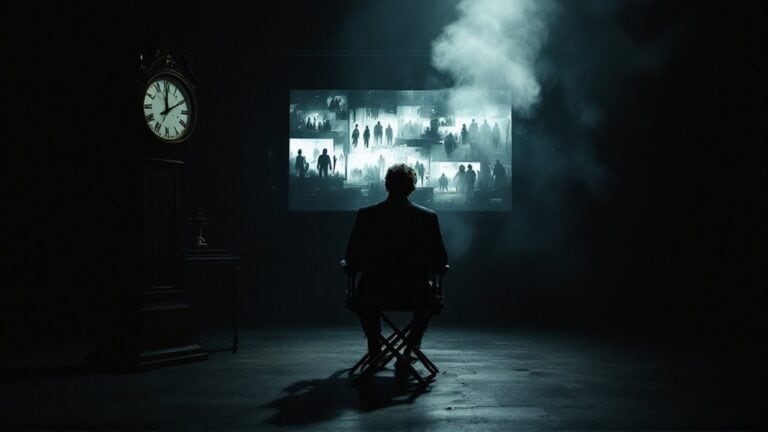The Role of Silence in Interstellar’s Sound Design
In *Interstellar*, silence serves as a profound element of sound design, enhancing the film’s emotional depth and tension. In the vastness of space, where sound waves cannot travel, silence symbolizes the isolation faced by characters, making their struggles feel more acute. This absence of sound creates poignant moments, inviting you to reflect on themes of loss and responsibility while immersing you in the narrative. Furthermore, the interplay between silence and impactful score highlights danger and vulnerability, reinforcing the film’s emotional stakes. Staying attuned to these nuances allows you to appreciate how sound shapes this cinematic experience on multiple levels.
Table of Contents
Key Takeaways
- Silence in *Interstellar* symbolizes the vastness of space, enhancing emotional stakes and inviting reflection on the narrative’s themes.
- The contrast between silence and sound enriches character relationships, emphasizing vulnerability and existential themes of loss and responsibility.
- Strategic use of silence heightens tension and danger during pivotal scenes, fostering active audience engagement with the story.
- Silence allows for undisturbed observations of the universe, enhancing the realism of the film’s portrayal of space.
- The innovative sound design transforms the viewing experience, making the emotional weight of each moment felt through deliberate sound choices.
Silence in Space
In the vast emptiness of space, silence reigns supreme due to the vacuum environment that lacks the molecules necessary to carry sound waves. This absence profoundly affects how we comprehend sound propagation and auditory perception. Without air, water, or solid mediums, sound can’t travel; it’s as if the universe itself has chosen to communicate solely through silence. Additionally, the strategic use of silence can enhance auditory experiences, allowing the listener to fully appreciate the surrounding sounds.
You might find it fascinating that astronauts rely on radio waves to communicate, bridging this void effectively, as electromagnetic waves can traverse the vast nothingness. In fact, the use of sound bridges in films like *Interstellar* cleverly mimics this concept by providing continuity across scenes despite the inherent silence of space.
Interestingly, while space is mainly silent, exceptions exist. Within gas and dust clouds, sound waves can propagate, albeit faintly. NASA even records phenomena like black holes, translating data into sound waves we can hear, showing that silence isn’t absolute. Detection of sound waves is possible in regions with gas and dust, providing insights into cosmic phenomena.
This creates a unique perspective on our universe, where the quiet can amplify our thoughts, allowing sensitive instruments to operate without interference.
Emotional Impact of Silence

While silence might seem like an absence, it actually plays an essential role in creating emotional depth in *Interstellar*. This absence of sound contrasts with the film’s vast soundscapes, enhancing the human dimension within the cold expanse of space. You feel the poignancy of emotional moments as silence emphasizes the vulnerability of characters, especially against an uncaring universe. It heightens tension, allowing you to anticipate the impact of subsequent sounds. The film employs total silence strategically to invigorate the viewing experience, reinforcing the emotional stakes of the narrative. Additionally, the emotional stakes are heightened through Cooper’s relationship with his children, particularly Tom and Murph. The sound design aims to create a sense of realism in science fiction filmmaking, which further deepens the audience’s connection to the characters’ emotional journeys.
The emotional resonance of silence also creates space for reflection, inviting you to process heart-wrenching themes like loss and parental responsibility. As you navigate the film, you’re drawn into intimate moments that are juxtaposed with grand, bombastic scores. This strategic use of silence fosters a sense of belonging, showing how love and connection can be as powerful as time itself.
| Element | Emotional Impact |
|---|---|
| Silence | Highlights vulnerability |
| Soundscapes | Creates immersive experiences |
| Contrast | Enhances emotional sensitivity |
| Intimate moments | Draws attention to relationships |
| Existential themes | Evokes fear and introspection |
In *Interstellar*, silence is far from empty; it’s a canvas for emotional depth.
Collaboration in Sound Design

When you think about collaboration in sound design, it’s crucial to recognize how the synergy between designers can shape emotional soundscapes that elevate a film’s narrative.
By working closely with each other, you not only blend individual talents but also create a richer auditory experience that resonates with the audience. This integration of ideas and emotions fosters a sound environment that enhances the storytelling, making every silence and sound count. The collaboration with director Christopher Nolan is a prime example of how sound designers can work together to achieve a unified vision. Furthermore, effective communication among team members ensures that all creative and technical aspects align seamlessly throughout the project. The use of realistic sound effects adds to the authenticity of the film’s immersive experience.
Synergy Between Designers
The collaboration among sound designers in “Interstellar” exemplifies a seamless synergy that elevates the film’s auditory experience. The synergy dynamics among Hans Zimmer, Richard King, and the mixing team created a tapestry of sound that deeply engages viewers. Each professional, from sound designer to mixer, contributed unique strengths, fostering an environment of collaborative creativity. Notable for groundbreaking sound design, this teamwork allowed them to push the boundaries of traditional audio experiences. Additionally, the focus on simplicity in sound design allowed the story to shine through without being overshadowed by complex audio elements.
| Role | Key Contributions | Impact on Sound Design |
|---|---|---|
| Sound Designer | Led the creation of sound effects | Crafted immersive auditory landscapes |
| Production Mixer | Recorded on-set dialogue | Enhanced dialogue integration |
| Re-Recording Mixer | Blended sound elements in post-production | Achieved a seamless auditory experience |
This tight teamwork was essential, as creative decisions made together emphasized both sound effects and dialogue integration. For instance, dialogue sometimes served as a sound effect, skillfully mixed beneath environmental sounds. The extensive post-production work guaranteed that every sound element contributed to the film’s emotional narrative. Christopher Nolan’s involvement reinforced the importance of sound as crucial in storytelling, guiding the designers in achieving a unified sound vision. Together, they created an auditory world that resonates with viewers, inviting them to experience the film on a profound level.
Emotional Soundscapes Integration
Building on the collaborative foundation established by the sound designers, “Interstellar” masterfully integrates emotional soundscapes that enrich the storytelling. The film’s score, highlighted by a powerful 60-person choir, adds an ethereal quality that evokes a profound sense of wonder and exploration. This depth creates an emotional connection, inviting you into the narrative’s heart, where themes of love, family, and the vast cosmos intertwine. The score’s rich ideas and emotional depth contribute significantly to this immersive experience, allowing the audience to connect with the film on a deeper level.
The sound design’s minimalist approach enhances the realism of the experience, allowing you to feel every nuanced moment. By skillfully blending orchestral and choral elements, the film crafts immersive experiences that resonate with your emotions. The community interaction noted through comments about the score further emphasizes its impact on listeners, showcasing how the positive feedback received contributes to its legacy.
The restraint shown in the sound design amplifies the emotional impact, letting silence play a vital role. It provides essential pauses, creating anticipation and allowing for reflection.
As you engage with these emotional soundscapes, you find yourself drawn deeper into the cinematic world. The thematic coherence of the score captures the essence of the story, transforming each scene into a memorable experience.
Ultimately, “Interstellar” uses sound to forge a connection that lingers long after the credits roll, making you feel part of something greater.
Techniques for Creating Silence

To understand how “Interstellar” creates its haunting silence, you can look at the strategic placement of sound and the use of natural ambience.
By contrasting intense musical moments with stretches of quiet, the film heightens emotional stakes and allows you to truly absorb the visuals unfolding on screen. This balance not only enriches your experience but also emphasizes the isolation and vastness of space, drawing you deeper into the narrative’s emotional core. The use of silence as a tool for tension and release effectively underscores the film’s themes of exploration and sacrifice.
Strategic Sound Placement
Strategic sound placement plays an essential role in crafting the silence that permeates *Interstellar*, enhancing its emotional depth and realism. By utilizing sound bridges, the film smoothly shifts from scene to scene, allowing certain sounds to linger, amplifying the sense of isolation and vastness inherent to space. This technique invites you to absorb the emotional weight of each moment before moving on.
Volume control is another key technique; by varying sound levels, the filmmakers create disorientation during tense moments, making silence even more impactful. The contrast between loud and quiet emphasizes the emotional states of characters, allowing you to feel their distress or resolve.
| Technique | Description | Emotional Impact |
|---|---|---|
| Sound Bridges | Join scenes with lingering sounds | Enhances reflection and connection |
| Volume Control | Varies sound levels for tension and clarity | Heightens emotional engagement |
| Silence in Shift | Creates a vast, isolating experience | Amplifies anticipation and unease |
Through these techniques, *Interstellar* invites you into its world, making you feel the silence as much as the sounds themselves, fostering a deep connection to its narrative.
Use of Natural Ambience
Natural ambience plays an essential role in the sound design of *Interstellar*, effectively creating moments of silence that heighten the film’s emotional resonance. By minimizing sound effects and incorporating natural sounds, the film crafts an atmosphere that immerses you in the vastness of space. The absence of conventional sounds, like roaring rocket engines, reinforces the hostile environment outside the spaceship, emphasizing the isolation that the characters experience.
You’ll notice how silence contrasts with the claustrophobic interior sounds of the ship, creating a palpable tension that mirrors the enormity of the universe. This technique of using silence as a sound effect not only adheres to scientific reality but also evokes profound emotional responses. As you watch, the breathing sounds of the characters humanize the silence, making you feel their vulnerability amidst the quiet.
Moreover, the film employs organic sounds over synthesized ones, enhancing atmosphere creation and adding authenticity to each scene. Every moment of silence invites you to reflect on the emotional weight of the journey, reminding you that sometimes, it’s the absence of sound that speaks the loudest.
Contrast With Musical Pacing
*Interstellar* masterfully contrasts silence with musical pacing to amplify emotional tension throughout its narrative. You’ll notice that dramatic drops in volume create stark silent moments, making the preceding sounds feel even more intense. This strategic manipulation of volume not only conveys broader emotional tones but also enhances the impact of the film’s deafening soundtracks.
When you experience scenes like the docking sequence, the silence that follows builds suspense, creating a shared anticipation. These pacing dynamics are expertly timed, allowing moments of complete silence to precede critical events, which intensifies the emotional weight of what’s about to happen.
In space, where sound is nonexistent, the intentional omission of audio enhances realism and heightens your engagement. Silence punctuates rhythms in the score, serving as a tool for reflection and a moment to process what you’ve just witnessed.
This contrast between silence and sound creates a unique emotional landscape, fostering a deeper connection to the story. Ultimately, the effective use of silence in *Interstellar* invites you to reflect, while the musical contrasts amplify the overall emotional experience, making the film unforgettable.
Innovations in Sound Design

While crafting the sound design for *Interstellar*, the team pushed boundaries to create a unique auditory experience. This journey of sound innovation marked a significant evolution in design, as they explored new techniques and instrumentation to evoke deep emotional responses.
You’ll notice how the unconventional choices shaped the film’s atmosphere:
- Forty-five scoring sessions were conducted, tripling the effort of *Inception*.
- A 1926 four-manual Harrison & Harrison Organ was chosen for its historical significance, delivering a grand, unexplainable sound.
- The strategic use of volume varied dramatically, creating moments that were both subtle and deafening.
- Silence punctuated the score, enhancing anticipation and allowing you to reflect on the unfolding narrative.
Hans Zimmer collaborated closely with Christopher Nolan, ensuring that every note matched the emotional weight of the scenes.
This synergy transformed sound into a powerful storytelling tool, allowing you to immerse yourself in the characters’ journeys. The design evolution seen in Interstellar isn’t just about what you hear; it’s about what you feel, making every moment resonate on a profound level.
The Role of Ambient Sounds

Ambient sounds play an essential role in building the film’s immersive experience, especially within the confines of the spacecraft. By incorporating ambient soundscapes, “Interstellar” creates realistic environments that draw you into the characters’ lives. The subtle room tone recorded on set enhances the authenticity of the spacecraft, making it feel like a lived-in space, rather than just a sci-fi backdrop.
You might notice how specific Foley sounds, like footsteps or the mechanical whirring of robots, add layers of realism, grounding the experience in something tangible.
Moreover, the minimal use of typical sci-fi sound effects allows you to engage more deeply with the film. Instead of flashy bleeps and bloops, you hear natural sounds, like ice scratching or gravel blowing, which evoke a sense of familiarity.
This choice fosters an emotional connection, making the characters’ struggles in vast, alien environments resonate more profoundly with you. The ambient sounds create a palpable tension, enhancing your emotional investment.
You find yourself not just watching, but feeling the isolation and weight of space, creating an unforgettable cinematic journey that lingers long after the credits roll.
Hans Zimmer’s Unique Score

Sound design in “Interstellar” sets the stage for Hans Zimmer’s unique score, which amplifies the film’s emotional depth. The score, driven by the ethereal sound of the organ, elevates the narrative, creating a poignant connection to the characters’ emotional journeys. You can feel the thematic evolution as it intertwines with the visuals, making it not just background music but a crucial part of the storytelling.
- The organ’s airy sound evokes the vastness of space while reminding you of the preciousness of every breath.
- Zimmer’s approach emphasizes emotional themes rather than conventional motifs, reflecting the love between a father and daughter.
- The main theme, composed before the full plot was revealed, mirrors the film’s heart, resonating deeply with viewers.
- Layering traditional and electronic elements, Zimmer crafts a unique sonic landscape that feels both grand and intimate.
This blend of innovative techniques and heartfelt inspiration results in a score that resonates on multiple levels, enhancing the film’s emotional resonance while inviting you to explore its rich thematic landscape.
In “Interstellar,” music becomes an essential thread that binds you to its profound narrative.
Contrast With Traditional Cinema

Interstellar’s sound design starkly contrasts with traditional cinema’s approach, particularly in the sci-fi genre. While many films rely on overwhelming sound effects and continuous atmospheric noise to create tension, Interstellar embraces silence symbolism, using quiet moments to enhance realism. This deliberate choice invites you to reflect on the vastness of space and the human experience within it.
| Traditional Cinema | Interstellar | Impact |
|---|---|---|
| Roaring engines, clashing ships | Silence in space | Heightened realism |
| Continuous background hums | No background noise | Emphasizes isolation |
| Bombastic music | Sparse non-diegetic music | Evokes deep emotions |
In exploring sound experimentation, the film minimizes effects, using them only when necessary. The contrast between the noisy spaceship and the silent void underscores the tension of space travel, enhancing your emotional connection to the characters. By avoiding the typical sound design norms, Interstellar not only captivates your imagination but also immerses you in a deeply human narrative, reminding you of vulnerability amidst the cosmic unknown. This unique approach invites you to experience a different kind of storytelling, one that resonates with authenticity and emotional depth.
Overall Impact on Immersion

How does the innovative sound design in *Interstellar* transform your viewing experience? By employing unique immersion techniques, the film draws you into an emotional landscape that feels both vast and intimate. The silence in space isn’t just an absence of sound; it represents the harsh reality of isolation. This juxtaposition enhances your sense of engagement with the story, making you feel the weight of each moment.
- Silence amplifies the danger and fear present in pivotal scenes.
- The internal sounds of the spaceship ground you in the characters’ reality.
- Realistic portrayals of space evoke a profound sense of authenticity.
- The balance between score and silence heightens emotional intensity.
As you watch, you’re not merely a spectator but an active participant in the narrative. The sound design pulls you into the experience, creating a sense of immediacy that’s hard to shake off.
Conclusion
In “Interstellar,” silence serves as a powerful tool, immersing you in the vastness of space while amplifying emotional moments. Imagine a scene where Cooper’s desperate attempts to communicate with Murph are met with stillness; the absence of sound heightens the tension, making each heartbeat resonate. This innovative use of silence, coupled with Hans Zimmer’s haunting score, reshapes your cinematic experience, inviting you to reflect on the profound connection between sound and emotion in storytelling.







